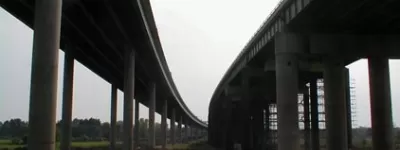In 1999, a short but significant piece of new motorway was opened to the east of Leeds, completing what had been an obvious gap in the trunk road network. On the face of it, this is a new but otherwise average piece of three-lane motorway - but building it provided more engineering challenges than meet the eye.
Adrian Shawcross, one of the engineers who worked on the project, describes some of the most difficult and impressive engineering on the road, accompanied by unique photographs that were taken during the road's construction.
The project
The M1-A1 Link Road was the name given to the project comprising the construction of a new motorway link between the M1 at Belle Isle to the south of Leeds and the A1 at Hook Moor to the east of Leeds, and included widening of the M62 between junctions 28 and 29, widening of the M1 between junctions 42 and 43 and upgrading of the A1 to motorway standard between Hook Moor and Bramham Crossroads.
The Highways Agency (formerly the Department of Transport) had been planning to extend the M1 motorway past Leeds to link up with the A1 Trunk Road since the late 1960s. There had been numerous studies, consultations and public inquiries to investigate possible route options for a new strategic highway link.
It was in 1968 that the Ministry of Transport first commissioned a study into the feasibility of providing a new or improved route to relieve the A1 in Yorkshire and to meet the needs of increasing traffic movements between the road network south of Leeds and the North East of England.

Throughout the 1970s, consultation was held on possible route options to the east and west of Leeds which culminated in a 12 month public inquiry commencing in May 1982 into the Kirkhamgate-Dishforth scheme which bypassed Leeds to the east and included provision for extensive lengths of upgrading the A1 Trunk Road between Bramham and Dishforth. The decision following the Public Inquiry confirmed that schemes to upgrade the A1 between Bramham and Dishforth would go ahead but that the published link route between the M1 and A1 should not proceed because of concerns over its environmental impact.
As a result of the decision a further study into the traffic problems and impacts on the road network to the east of Leeds was commissioned in 1985. Following detailed investigations a recommendation for a new route for the M1/A1 Link Road was announced by the Secretary of State for Transport, in November 1987.
Further public consultation into the new route was conducted in November 1989 with details of the preferred scheme published and considered at Public Inquiry in January 1993.
Orders to proceed towards construction were announced by the Minister for Roads and Traffic in November 1993.
Eventually it was decided to award the contract as a Design Build and Operate scheme. The project would be financed by private finance and a concession company would operate the scheme for 40 years after contract award. The scheme would eventually be paid for by the use of shadow tolls, payments based on the amount of vehicles using the road. Due to the high costs of tendering for a contract of this type, the M1/A1 Link Road Project included widening of the M62, M1 motorways and upgrading of the A1 to motorway standard.
The contract for the project was awarded to the DBFO concession company Yorkshire Link, a joint venture between BICC Group and Kvaerner Group, in March 1996. Construction began in March 1996 approximately 1 month after contract award. The project was completed and opened to traffic in February 1999. The project included one hundred and fifty structures: 1 viaduct, 2 tunnels, 37 bridges, 8 underpasses, 2 footbridges, 3 major culverts, 85 sign/ signal gantries, and 18 CCTV masts.
Work stages
The work fell into three distinct sections:
Stage 1
Widening of the M62 between junction 29 and 30 (Tingley to Lofthouse), widening of the M1 between junctions 42 and a new interchange constructed to the south of junction 43, construction of part of the M1/A1 Link Road to the Stourton railway crossing and construction of two free flow link roads at the Lofthouse interchange.
Stage 2
Construction of the M1/A1 Link Road between Stourton railway crossing and Hook Moor interchange.
Stage 3
Parallel reconstruction of the A1 to motorway standard between Hook Moor interchange and Bramham Crossroads junction and the construction of free flow link roads between the A1(M) and A64 at Bramham Crossroads.
Sources
- New Civil Engineer Roads Supplement, June 1997, pp 9-11.
- New Civil Engineer Concrete Engineering Supplement, November 1997, pp 24-26.
- M1/A1 Link Road - The Yorkshire Link, produced by Yorkshire Link, Spring 1999.
